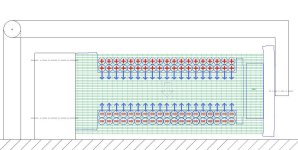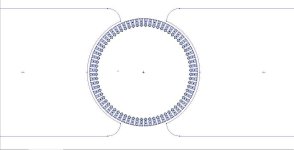Alan B
100 GW
kiwifiat said:Alan B said:Clearly there is a lot of confusion about this topic across the web, there are similar discussions on the net that don't end in clarity. I have done many, many searches and not found a good explanation of why parts of the turns on a tooth in a BLDC core are not contributing to torque. Even a proper definition of exactly what is, or is not included in the end turns is in absentia.
I do agree that the conductor that leaves the tooth and ventures across to the next tooth is not going to provide useful flux to the tooth. Clearly that is an "end turn" and does not contribute to "useful flux". So if that's how "end turns" are defined, then I'm good with that. If somehow part of the wire wrapping around the tooth itself is discounted, I'd like to see a precise reason why.
The force generated on a conductor of length l with current i in a field of strenght B is given by F = ilBsinϕ when ϕ is 90° sin90 = 1. That situation is applicable to the turns in the slot and thus slot turns produce maximum contribution to torque production. The "end turns" are at ϕ=0 with respect to B and since sin0 = 0 there is no force generated. This fact is easily verified experimentally. If you can accept this verifiable fact it should be possible to accept that end turns do not contribute to torque production. To say they are bad is a stretch, plainly they are a necessity. End turns add inductance which is good for controllers, they also help dissipate heat and add to the heat capacity of the motor which is also a positive. As Luke points out end turns are outside the air gap and regardless of their angle with respect to B no force is generated. That is to say that force is generated only by the cross product of stator and rotor flux in the air gap. Luke has done this experiment and given that I did something similar in a physics lab many decades ago I have every reason to trust his reported results. That is the great thing about science, if you don't beleive do the experiment.
If the proof is in the pudding then every paper I have ever read that derives sizing equations from first principles and then goes on to design,build and test said motor the results have without exception agreed closely with those forecast by the sizing equations. Given that some of the brightest minds ever to grace planet earth have contributed to the collective knowledge of humanity in this field I have yet to see one reason to doubt what I read in text books, IEEE papers or doctoral theses( I had to google the plural of thesis) especially when I have verified a number of the fundamental laws first hand.
This explanation seems to ignore the effect of the high permeability core material. So it falls short of fully explaining the situation we are trying to understand. I think we have also seen direct calculations that show when there is a high permeability core the wires are no longer receiving the dominant forces, the forces act across the gap on the core directly. So the directions and angles of the conductors are removed from the dominant force equations, the stator is effectively a bar magnet at that point and the forces should all be derivable from a bar magnet equivalent of the stator tooth at that position and strength.
All the wire turns are out of the air gap in our BLDC motors, only the core and magnet poles are at the gap. The turns and current only serve to align the magnetic domains in the stator tooth which in turn produces the dominant flux. The flux from the wires alone, in absence of the core is at too great an airgap (and too weak without the magnification of the permeability) to have significance in the torque production. The mode of operation of this BLDC motor appears to change when high permeability materials are introduced into the system. This is a different motor operating on a different principle than a coreless model.
I have no reason to doubt these examples which you cite, however I have seen none of them that describe the effect of the core, and how the B field at the gap, which now comes primarly from the stator magnetic domains having been aligned by the field from the turns (and not from the turns themselves), knows anything about the directions of currents in the wires wrapped around the tooth anymore.
If any of these examples cover the complete situation and discuss the how the core materials interact with the windings and the motor poles in detail please specifically cite them, that would be of great value to this discussion.
Thanks!






